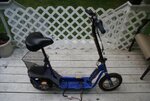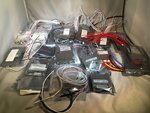Hey Forum.
In designing a battery pack, I'm deciding what batteries to try to find and what configuration to use. I have been trying to figure out what max amp for range battery can fit in my old e350 schwinn scooter. Right now i am running a lithium pack i bought years ago in the back basket which does not fit in the bottom battery compartment. I am also running over volted, but it does wheelies unless i put weight forward, because battery is behind the center of gravity. The maximum shape the battery the intended battery compartment can hold is rectangle of 305mm (12 inches)x 118mm (4,75 inches) x 68mm (2,75 inches), so i want to build a pack that is equal too or smaller than that size, including the bms. So I have two questions really, What battery cells, where to suggest purchasing and how to configure them. I actually have a lot of electrical experience and I can figure most of the shape and parallel series stuff out, even the BMS. You tube is very helpful, but my dimensions are unique and I do not see any battery packs for sale with both the 2.75 inch and 4.75 inch limitations on two of the dimensions. I am going to make a battery style spot welder with a solenoid so i will be spot welding and not soldering. One Chinese seller on ebay says he can configure a pack that will fit for $229.00. he says "We can make the battery smaller than that size with a 20A BMS using new G25 2500mAH 8A 3C The battery model is 36V 15Ah (10S6P) build within 60 pieces of G25 cells. The cells are quality" should i copy his specs?. I so not see g25 cells much on the web for sale. i want to choose good cell and know where to purchase the best cells. Im in no rush but really want to hear people opinion. As too my current configuration. Right now I am running a a 36volt 750 watt 16amp pack with 24volt 500 watt brushed controller and and over volted 25v 500 watt motor running at the 36volts. I have uploaded a pic from the web on the type of scooter compartment i am fitting the pack into. Any help appreciated!!!!!!!
In designing a battery pack, I'm deciding what batteries to try to find and what configuration to use. I have been trying to figure out what max amp for range battery can fit in my old e350 schwinn scooter. Right now i am running a lithium pack i bought years ago in the back basket which does not fit in the bottom battery compartment. I am also running over volted, but it does wheelies unless i put weight forward, because battery is behind the center of gravity. The maximum shape the battery the intended battery compartment can hold is rectangle of 305mm (12 inches)x 118mm (4,75 inches) x 68mm (2,75 inches), so i want to build a pack that is equal too or smaller than that size, including the bms. So I have two questions really, What battery cells, where to suggest purchasing and how to configure them. I actually have a lot of electrical experience and I can figure most of the shape and parallel series stuff out, even the BMS. You tube is very helpful, but my dimensions are unique and I do not see any battery packs for sale with both the 2.75 inch and 4.75 inch limitations on two of the dimensions. I am going to make a battery style spot welder with a solenoid so i will be spot welding and not soldering. One Chinese seller on ebay says he can configure a pack that will fit for $229.00. he says "We can make the battery smaller than that size with a 20A BMS using new G25 2500mAH 8A 3C The battery model is 36V 15Ah (10S6P) build within 60 pieces of G25 cells. The cells are quality" should i copy his specs?. I so not see g25 cells much on the web for sale. i want to choose good cell and know where to purchase the best cells. Im in no rush but really want to hear people opinion. As too my current configuration. Right now I am running a a 36volt 750 watt 16amp pack with 24volt 500 watt brushed controller and and over volted 25v 500 watt motor running at the 36volts. I have uploaded a pic from the web on the type of scooter compartment i am fitting the pack into. Any help appreciated!!!!!!!




